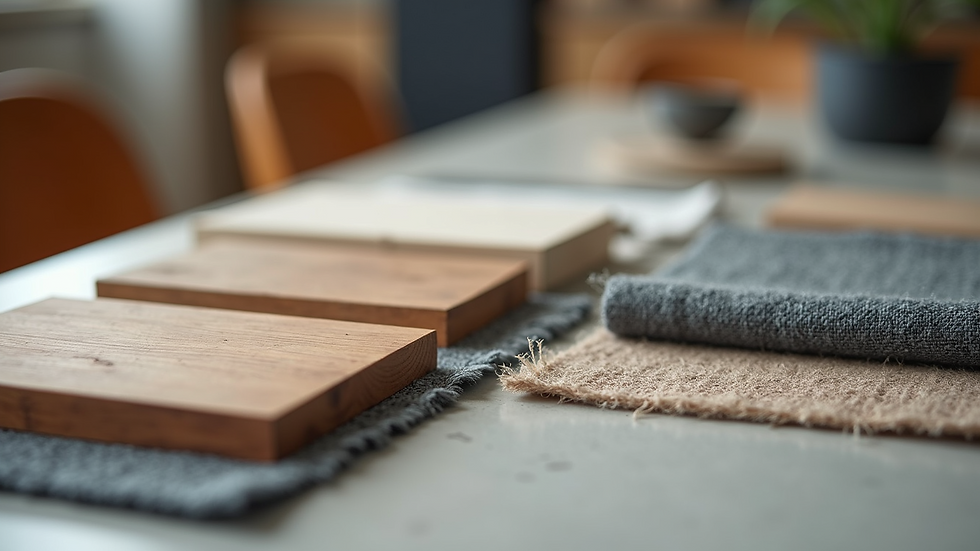Top Tips for Choosing the Right Design Materials
- Ericka Brower
- Nov 3
- 3 min read
Choosing the right materials for your design project can make all the difference between a successful outcome and a costly mistake. Whether you are working on interior design, product development, or graphic design, the materials you select affect durability, aesthetics, functionality, and budget. This guide offers practical advice to help you make informed decisions when selecting design materials.

Understand Your Project Needs
Before diving into material options, clearly define what your project requires. Ask yourself:
What is the purpose of the design?
Will the materials face heavy use or wear?
Are there environmental conditions to consider, such as moisture or sunlight exposure?
What is the expected lifespan of the product or space?
For example, a kitchen countertop needs materials that resist heat, stains, and scratches, while a decorative wall panel might prioritize appearance over durability.
Consider Material Properties
Each material has unique characteristics that influence its suitability:
Durability: How well does the material withstand wear and tear?
Weight: Is the material light enough for your design or does it require extra support?
Texture and Finish: Does the surface feel smooth, rough, glossy, or matte? This affects both look and touch.
Maintenance: Will the material require frequent cleaning or special care?
Cost: How does the price fit within your budget?
For instance, natural wood offers warmth and beauty but may need sealing to prevent damage, while metal provides strength but can be prone to rust without treatment.
Match Materials to Style and Function
Your design’s style guides material choices. A modern minimalist design often uses sleek metals, glass, or polished concrete. In contrast, rustic or traditional styles favor natural wood, stone, or textured fabrics.
Functionality also matters. Outdoor furniture requires weather-resistant materials like treated wood or synthetic fibers. Indoor upholstery benefits from fabrics that resist stains and fading.
Test Samples Whenever Possible
Handling material samples gives insight beyond photos or descriptions. Touch the texture, see how light reflects, and check the color in your project’s lighting conditions. Small differences in shade or finish can change the overall look.
If you are selecting paint or fabric, test a small area first. This helps avoid surprises after installation.
Think About Sustainability
Sustainable materials reduce environmental impact and often add value to your design. Look for:
Recycled or reclaimed materials
Rapidly renewable resources like bamboo or cork
Low-VOC paints and finishes
Certifications such as FSC for wood
Choosing eco-friendly materials supports responsible design and can appeal to environmentally conscious clients or users.
Balance Budget and Quality
While it’s tempting to choose the cheapest option, low-cost materials may compromise quality and longevity. Conversely, premium materials might exceed your budget without significant benefits.
Aim for a balance by prioritizing materials where quality matters most. For example, invest in durable flooring but choose cost-effective wall finishes.
Plan for Installation and Maintenance
Some materials require professional installation or special tools. Others may be easy to work with but need ongoing maintenance.
Consider:
Can you install the material yourself or will you need experts?
What cleaning products or methods are safe?
How often will maintenance be needed?
Materials that are difficult to maintain might not suit busy households or commercial spaces.
Use Materials That Complement Each Other
When combining materials, ensure they work well together visually and physically. Mixing textures, colors, and finishes can create interest but avoid clashes.
For example, pairing warm wood tones with cool metals can balance warmth and modernity. Avoid materials that react negatively when in contact, such as certain metals and acidic stones.
Stay Updated on Trends and Innovations
Material technology evolves rapidly. New composites, finishes, and treatments can offer better performance or aesthetics.
Stay informed by:
Visiting trade shows or design fairs
Reading industry publications
Consulting with suppliers or manufacturers
Innovative materials might provide solutions to challenges like weight reduction, durability, or sustainability.
Document Your Choices
Keep detailed records of your material selections, including supplier information, specifications, and care instructions. This helps with future repairs, replacements, or expansions.
Summary
Choosing the right design materials requires understanding your project’s needs, balancing style and function, and considering durability, maintenance, and budget. Testing samples and staying informed about new materials can improve your decisions. Thoughtful material selection enhances the quality and longevity of your design, making your project both beautiful and practical.
Start your next project by carefully evaluating materials. This step sets the foundation for success and satisfaction with your design outcomes.


Comments